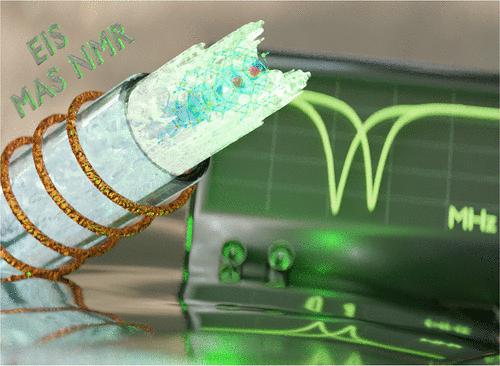当前位置:
X-MOL 学术
›
Anal. Chem.
›
论文详情
Our official English website, www.x-mol.net, welcomes your feedback! (Note: you will need to create a separate account there.)
Noncontact In Situ Multidiagnostic NMR/Dielectric Spectroscopy
Analytical Chemistry ( IF 7.4 ) Pub Date : 2024-03-21 , DOI: 10.1021/acs.analchem.3c03007 Alysson F. Morais 1, 2 , Sambhu Radhakrishnan 1, 2 , Gavriel Arbiv 1, 2, 3 , Dirk Dom 1, 2 , Karel Duerinckx 1, 2 , C. Vinod Chandran 1, 2 , Johan A. Martens 1, 2 , Eric Breynaert 1, 2, 3
Analytical Chemistry ( IF 7.4 ) Pub Date : 2024-03-21 , DOI: 10.1021/acs.analchem.3c03007 Alysson F. Morais 1, 2 , Sambhu Radhakrishnan 1, 2 , Gavriel Arbiv 1, 2, 3 , Dirk Dom 1, 2 , Karel Duerinckx 1, 2 , C. Vinod Chandran 1, 2 , Johan A. Martens 1, 2 , Eric Breynaert 1, 2, 3
Affiliation

|
Introduction of a dielectric material in a nuclear magnetic resonance (NMR) probe head modifies the frequency response of the probe circuit, a phenomenon revealed by detuning of the probe. For NMR spectroscopy, this detuning is corrected for by tuning and matching the probe head prior to the NMR measurement. The magnitude of the probe detuning, “the dielectric shift”, provides direct access to the dielectric properties of the sample, enabling NMR spectrometers to simultaneously perform both dielectric and NMR spectroscopy. By measuring sample dielectric permittivity as a function of frequency, dielectric permittivity spectroscopy can be performed using the new methodology. As a proof of concept, this was evaluated on methanol, ethanol, 1-propanol, 1-pentanol, and 1-octanol using a commercial cross-polarization magic angle spinning (CPMAS) NMR probe head. The results accurately match the literature data collected by standard dielectric spectroscopy techniques. Subsequently, the method was also applied to investigate the solvent-surface interactions of water confined in the micropores of an MFI-type, hydrophilic zeolite with a Si/Al ratio of 11.5. In the micropores, water adsorbs to Bro̷nsted acid sites and defect sites, resulting in a drastically decreased dielectric permittivity of the nanoconfined water. Theoretical background for the new methodology is provided using an effective electric circuit model of a CPMAS probe head with a solenoid coil, describing the detuning resulting from the insertion of dielectric samples in the probe head.
中文翻译:

非接触式原位多重诊断核磁共振/介电谱
在核磁共振 (NMR) 探头中引入介电材料会改变探头电路的频率响应,这是通过探头失谐揭示的现象。对于 NMR 光谱,可通过在 NMR 测量之前调整和匹配探头来校正这种失谐。探针失谐的幅度(“介电位移”)可以直接了解样品的介电特性,使 NMR 波谱仪能够同时执行介电波谱和 NMR 波谱分析。通过测量作为频率函数的样品介电常数,可以使用新方法进行介电常数谱分析。作为概念验证,我们使用商用交叉偏振魔角旋转 (CPMAS) NMR 探头对甲醇、乙醇、1-丙醇、1-戊醇和 1-辛醇进行了评估。结果与标准介电谱技术收集的文献数据精确匹配。随后,该方法还应用于研究 Si/Al 比为 11.5 的 MFI 型亲水沸石微孔中限制的水的溶剂-表面相互作用。在微孔中,水吸附到布朗斯台德酸位点和缺陷位点,导致纳米约束水的介电常数急剧下降。使用带有螺线管线圈的 CPMAS 探头的有效电路模型提供了新方法的理论背景,描述了在探头中插入电介质样品所产生的失谐。
更新日期:2024-03-21
中文翻译:

非接触式原位多重诊断核磁共振/介电谱
在核磁共振 (NMR) 探头中引入介电材料会改变探头电路的频率响应,这是通过探头失谐揭示的现象。对于 NMR 光谱,可通过在 NMR 测量之前调整和匹配探头来校正这种失谐。探针失谐的幅度(“介电位移”)可以直接了解样品的介电特性,使 NMR 波谱仪能够同时执行介电波谱和 NMR 波谱分析。通过测量作为频率函数的样品介电常数,可以使用新方法进行介电常数谱分析。作为概念验证,我们使用商用交叉偏振魔角旋转 (CPMAS) NMR 探头对甲醇、乙醇、1-丙醇、1-戊醇和 1-辛醇进行了评估。结果与标准介电谱技术收集的文献数据精确匹配。随后,该方法还应用于研究 Si/Al 比为 11.5 的 MFI 型亲水沸石微孔中限制的水的溶剂-表面相互作用。在微孔中,水吸附到布朗斯台德酸位点和缺陷位点,导致纳米约束水的介电常数急剧下降。使用带有螺线管线圈的 CPMAS 探头的有效电路模型提供了新方法的理论背景,描述了在探头中插入电介质样品所产生的失谐。



























 京公网安备 11010802027423号
京公网安备 11010802027423号